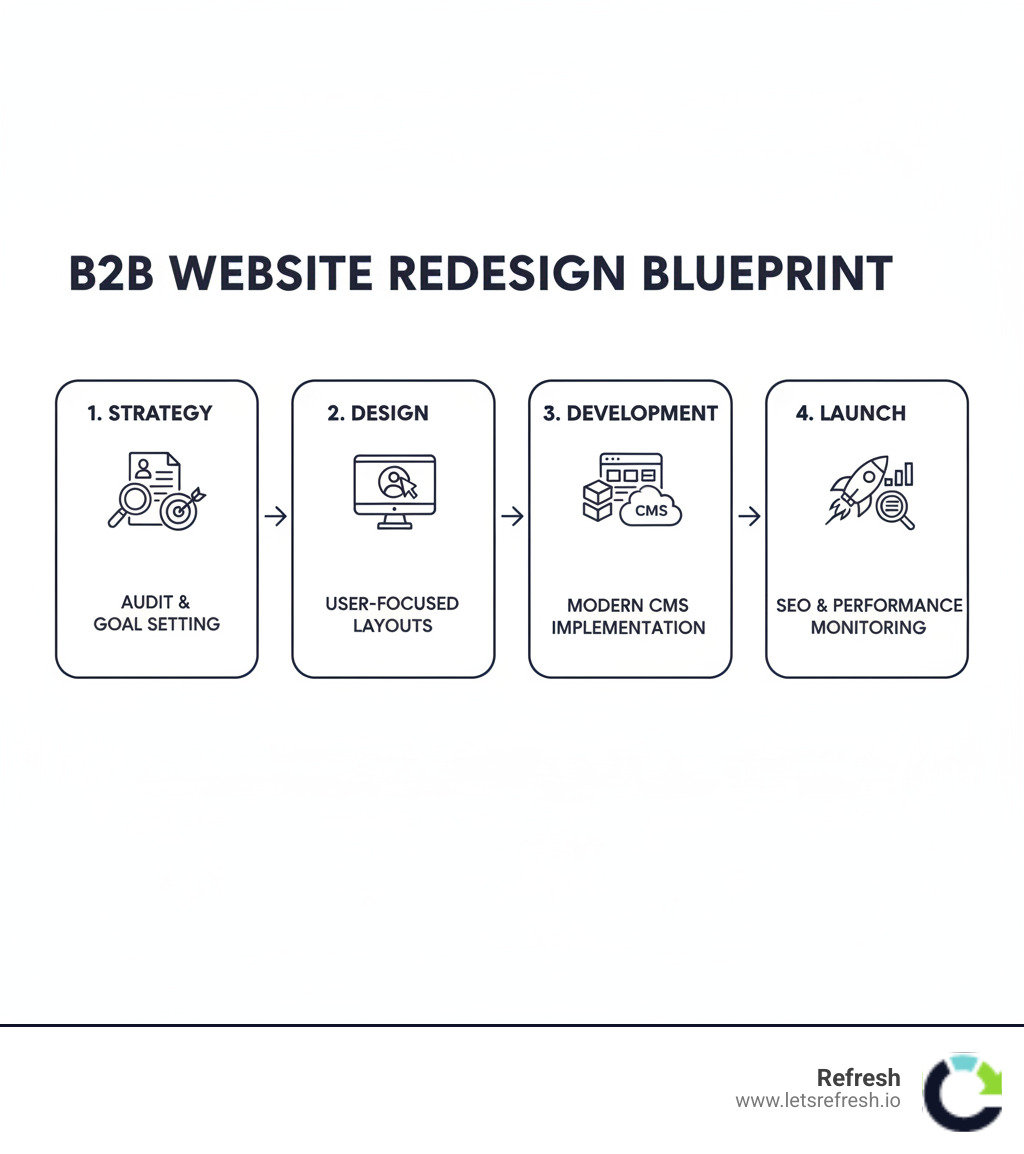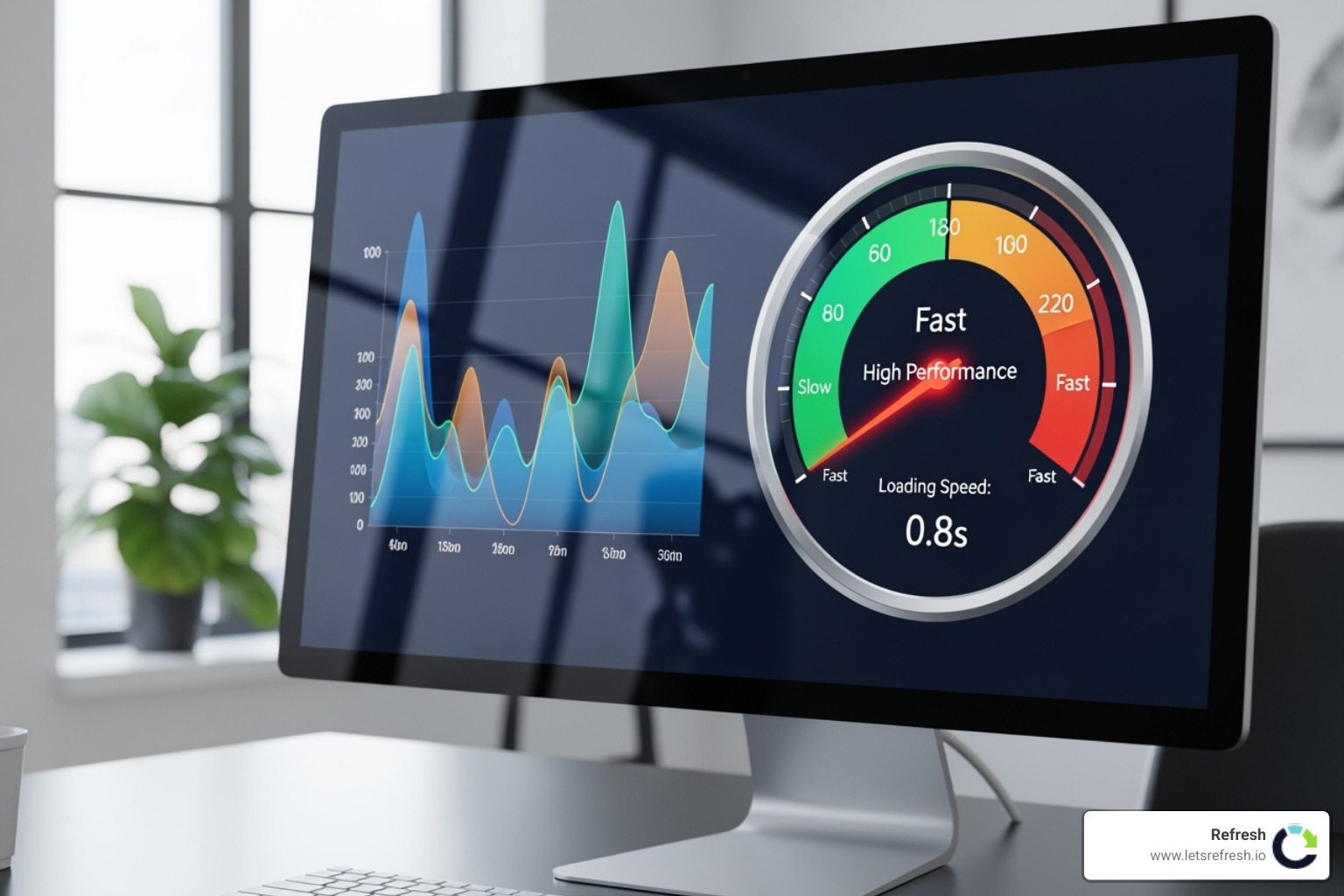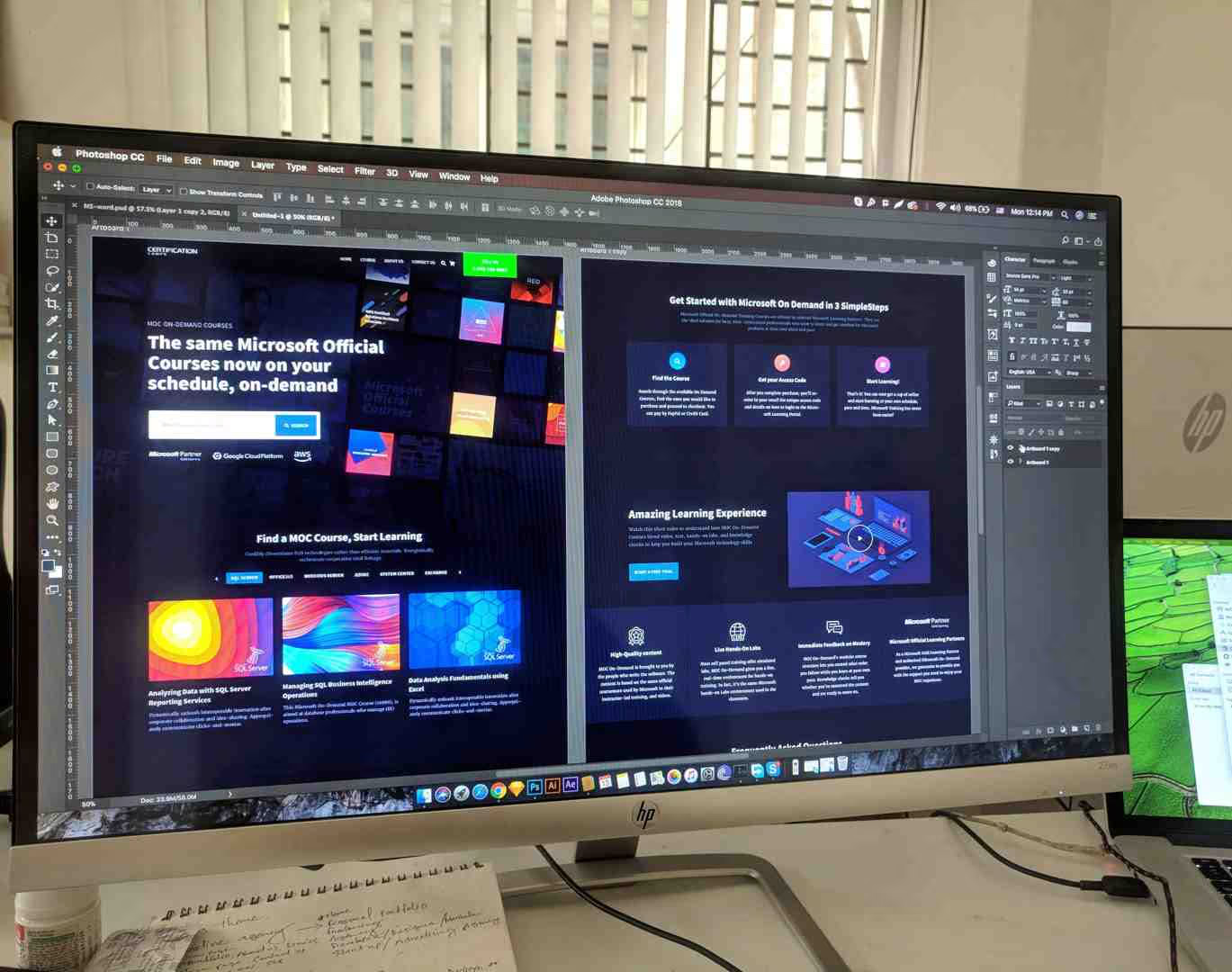October 10, 2025
Why B2B Website Redesigns Are Critical for Business Growth
A B2B website redesign is the strategic process of rebuilding your website to improve performance, user experience, and conversion rates. It involves four key phases:
- Strategy Phase: Audit current site, define goals, research competitors
- Design Phase: Create user-focused layouts, optimize for conversions
- Development Phase: Build on a modern CMS, ensure mobile responsiveness
- Launch Phase: Implement SEO, test performance, monitor results
Your website should be a growth engine, not a headache. Research shows 76% of customers prioritize finding information quickly on a website, yet many B2B companies have outdated sites that fail to convert visitors.
With only half a second to make a first impression, a site that isn't built to convert leaves revenue on the table. A well-designed B2B website is a valuable business asset that builds user trust and supports buyers through complex sales cycles. If you don't prove your value in seconds, most visitors will leave and won't return. Getting your redesign right is critical for long-term success.
I'm Alexander Palmiere, Founder and CEO of Refresh Digital Strategy. I've launched over 200 websites for SMBs and have seen how a strategic B2B website redesign can transform a company's digital presence and drive measurable growth.

Key B2B website redesign vocabulary:
The 'Why': Key Triggers for a B2B Website Overhaul
Key triggers often signal the need for a B2B website redesign. It's rarely about a new look; it's about fixing fundamental issues that hurt your bottom line. Here are the most common reasons for an overhaul:
Outdated design: A dated look or confusing navigation frustrates users and leads to high bounce rates. Simpler, modern designs create a better user experience.
Poor performance and declining leads: Low conversion rates, high bounce rates, and poor engagement are clear signs your site isn't built to convert, leaving revenue on the table.
Difficult content management system (CMS): A clunky CMS creates workflow delays and errors. If your team struggles to update content, your website is a headache, not a growth engine.
Brand misalignment: This occurs when your site no longer reflects your company's values or offerings. As your digital storefront, it must align with your brand to engage customers.
Poor mobile experience: With mobile traffic dominating, a non-responsive site frustrates users and gets penalized by Google. A seamless mobile experience is a requirement.
Low search engine rankings: Poor optimization reduces visibility. A redesign is the perfect opportunity to build a strong SEO foundation so ideal clients can find you.
Negative user feedback: Complaints about speed, navigation, or content are a clear call for an overhaul. This feedback, paired with analytics, highlights your site's shortcomings.
A B2B website redesign is a strategic investment in your business's future, ensuring your digital presence becomes a powerful asset. For more on this, check out The Transformative Power of a Website Redesign for Small Businesses.
The 'How': Your Pre-Launch Blueprint for a B2B Website Redesign
A B2B website redesign requires a solid plan. A thorough redesign takes months, not weeks, because complex integrations, content work, and testing are critical for long-term success. Here's our proven blueprint:

- Define Your 'Why' and Set Goals: Before starting, determine why you're redesigning. Whether it's boosting lead generation or improving brand perception, your goals will guide every decision.
- Conduct a Site Audit: Analyze engagement metrics, page performance, mobile responsiveness, and SEO. We combine analytics with user feedback to identify weaknesses and opportunities.
- Secure Stakeholder Buy-In: Build your case by focusing on ROI, revenue growth, and brand reputation. Use competitor benchmarks and user feedback to motivate action.
- Plan Budget and Timeline: Be realistic and account for hidden costs like content migration, SEO, and ongoing maintenance from the start. For tips, see New Year, New Website: Tips for a Successful Redesign in 2024.
- Review Your Tech Stack: Your site connects to CRMs and other tools. Address these integrations early to prevent costly surprises.
Setting and Measuring KPIs for Your B2B Website Redesign
To measure success, set clear, measurable goals (KPIs) before you launch. First, benchmark your baseline metrics. Key KPIs for B2B sites include:
- Conversion Rates: Track form submissions, demo requests, and downloads.
- Organic Traffic and Lead Quality: Monitor not just the volume of visitors but also how well they convert into qualified sales opportunities.
- Engagement Metrics: Session duration, bounce rate, and pages per session reveal content value. Increased engagement and direct traffic often correlate with better lead quality and brand recognition.
Set SMART goals for each metric, such as, "Increase qualified lead submissions by 25% within six months post-launch." This strategic approach is key to a strong digital strategy.
Content Inventory and Strategy
Content planning is a complex process of auditing, restructuring, and mapping content to a new information architecture. It's not just a simple copy-paste job.
- Content Audit: Examine all existing content to decide what to keep, refresh, or discard based on performance.
- Information Architecture (IA): Map out the new site structure to create logical pathways that guide users toward conversion.
- Content Migration Plan: Detail the process for content entry, formatting, SEO, and mapping to prevent broken links and missing pages.
- New Content Strategy: Identify content gaps and plan new assets (e.g., case studies, whitepapers) aligned with your SEO Digital Marketing Content Strategy.
Choosing Your Redesign Team
This decision impacts your budget, timeline, and success. Consider your options:
- DIY: This approach is often slow and limited by internal bandwidth, leading to extended timelines and compromised quality.
- Freelancers: Effective for specific tasks, but managing a complex project yourself can be challenging.
- Agency: Partnering with an agency like Refresh is a higher investment but provides comprehensive expertise, structured processes, and accountability. It's often the most reliable option for complex projects.
Honestly assess your internal capacity for UI/UX design, research, and technical integrations. Our team specializes in Webflow, a powerful platform for B2B sites. Learn more about our work as a Webflow Development Company.
Common Pitfalls to Avoid
Avoid these expensive mistakes during your B2B website redesign:
- Underestimating Content Migration: This complex task requires significant time and budget.
- Ignoring Integrations: Plan for CRM and other system connections from day one.
- Scope Creep: Stick to your original, clear goals to prevent the project from expanding.
- Unclear Goals: Define specific, measurable outcomes, not vague wishes.
- Insufficient Budgets: A cheap redesign often leads to an expensive do-over. Be realistic about the investment.
- Poor Communication: Maintain clear expectations and open communication with your team.
- Neglecting SEO: SEO must be integrated throughout the redesign to ensure visibility.
The 'What': Designing a High-Converting B2B Experience
This phase brings your B2B website redesign to life through user experience (UX) and user interface (UI) design. UI is the visual look, while UX is the strategic thinking that ensures every interaction is intuitive.
We use our Authority Architecture Framework to design around your customer's journey, guiding them from browser to qualified lead. Simpler designs create better experiences for busy B2B buyers. A well-executed redesign transforms your site into a business asset that builds trust and supports buyers through long sales cycles.
Key Differences in B2B Website Redesign vs. B2C
Designing for B2B buyers is different from B2C. They are making calculated business decisions, not impulse buys. Key differences include:
- Longer Sales Cycles: B2B purchases are marathons. Buyers, often in groups of 6-10 decision-makers, conduct extensive research.
- Relationship Focus: B2B sites nurture relationships and build trust for deals that often close offline.
- Logic Over Emotion: B2B buyers make calculated decisions based on ROI, long-term value, and system integration.
- Higher Scrutiny: Large investments demand detailed information, case studies, and proof of results.
- Industry Expertise is Key: Your audience expects you to speak their language and understand their challenges.
Designing the Homepage and Other Crucial Pages
Your B2B website redesign must guide complex buyers through their journey.
The Homepage: Your Digital First Impression
Your homepage must quickly communicate your value. Key elements include:
- Clear Value Proposition: Instantly explain who you are, what problem you solve, and for whom.
- Social Proof: Use client logos, testimonials, and case study highlights to build trust.
- Intuitive Navigation: Make it easy for different stakeholders to find what they need.
- Strategic Calls-to-Action (CTAs): Guide visitors to the next logical step, like requesting a demo.
Other Crucial Pages: Building Trust and Providing Depth
Beyond the homepage, every page should serve a purpose:
- About Us Page: Build human connection. Show buyers who you are and that you understand their industry. Learn how to craft a great one in Crafting Compelling About Us Pages.
- Case Studies and Testimonials: Provide the social proof B2B buyers need. Show, don't just tell, how you deliver measurable results.
- Pricing Page: Be transparent. If pricing is complex, provide a clear path to a custom quote to build trust.
- Resources and Blog: Establish yourself as a trusted advisor with in-depth content. Find Why Your Business Needs a Blog.
- Contact and Support Pages: Make it easy to connect with a real person, as B2B buyers often need to before committing.
Mastering B2B Lead Generation: CTAs, Forms, and Trust
B2B lead generation is about creating a value exchange. Here's how to build trust and drive conversions:
- Strategic CTAs: Use specific, value-oriented language (e.g., "Download Case Study") instead of generic "Submit."
- Lead Magnets: Offer high-quality resources like reports or webinars in exchange for contact information.
- Simple Web Forms: Respect users' time. Ask only for essential information initially, as every extra field reduces conversions.
- Chatbots and Live Chat: Answer questions, qualify leads, and provide immediate value.
- CRM Integration: Connect your site to your CRM (e.g., HubSpot, Salesforce) to ensure no lead is lost and enable quick sales follow-up.
The 'Tech': Building a Future-Proof Foundation
The technical foundation of your B2B website redesign is critical. A future-proof site must be fast, secure, and adaptable. Key technical elements include:

- Technical SEO: This is the backbone of online visibility. A well-optimized site with proper URL structures, meta descriptions, and alt tags is crucial for ranking in search results.
- 301 Redirects: These are a safety net during a redesign. They point old URLs to new ones, preserving SEO authority and preventing 404 errors.
- XML Sitemap: This acts as a roadmap for search engines, helping them efficiently crawl and index your new site structure.
- Composable Architecture: This modular approach improves flexibility, scalability, and user experience, making it a future-proof choice for modern websites.
- CMS Choice: This is foundational. We recommend Webflow for its flexibility, visual development, and robust performance. Learn more about Why Webflow is the Better Choice for Your Business.
The Critical Role of Performance and Mobile Responsiveness
Performance and mobile responsiveness are make-or-break factors. A slow website sends buyers to your competition, as nearly 70% of consumers state that page speed impacts their willingness to buy.
The highest conversion rates occur on pages with load times between 0-2 seconds. Faster load times lead to lower bounce rates and higher Google rankings.
Mobile-first design is essential. With growing mobile traffic, a responsive design that renders quickly on any device is a requirement. A poor mobile experience frustrates leads and damages your brand's image. Responsive design is key to providing the best user experience and building trust. For more, see Maximizing Website Performance: Tips and Best Practices.
Post-Launch: Monitoring, Testing, and Iteration
Launch isn't the finish line. A successful B2B website redesign requires continuous evolution based on data and user feedback.
- Monitoring KPIs: Track performance against pre-launch benchmarks to identify what's working and what needs adjustment.
- A/B Testing: Remove guesswork by comparing different versions of pages, CTAs, or forms to see which performs better.
- Heatmaps and User Feedback: Gain insights into user behavior by seeing where they click and scroll. This data reveals the gap between assumptions and reality.
- Continuous Improvement: The digital landscape is always changing. We test and experiment to optimize underperforming pages and improve results.
- SEO Performance Tracking: Monitor rankings, traffic, and crawl reports to ensure optimization efforts are effective and address issues quickly.
Frequently Asked Questions about B2B Website Redesigns
A B2B website redesign is a big decision. Here are answers to common questions about timelines, costs, and SEO.
How long does a B2B website redesign typically take?
A thorough B2B website redesign takes months, not weeks. Rushing the process leads to poor results. The timeline depends on:
- Project Scope: A simple refresh may take 6-8 weeks, while a complex overhaul with custom integrations can take 4-6 months or longer.
- Content Creation: This is often underestimated and takes significant time and coordination.
- Integrations: Connecting to CRM and other business systems adds complexity, as each requires careful testing.
- Team Availability: Both internal and external team capacity affects the timeline.
Expect a timeline of 3 to 6 months for most comprehensive B2B sites. It's a time investment that pays off.
How much does a B2B website redesign cost?
The cost of a B2B website redesign varies widely. Key factors include:
- Scope, Complexity, and Design Quality: A custom, 100-page site with complex integrations will cost significantly more than a basic 10-page site.
- Content and Development Needs: Extensive content work and custom coding require specialized expertise and add to the cost.
- Your Team Choice: DIY is cheapest but resource-intensive. Freelancers are a middle ground. An agency like Refresh is a higher investment but provides a full team, accountability, and strategic guidance.
Remember to budget for hidden costs like SEO setup, ongoing maintenance, and software subscriptions. Basic redesigns can start around $10,000-$20,000, but comprehensive B2B projects often range from $30,000 to $100,000+. View this as an investment in a growth engine that pays for itself through increased leads and conversions.
How do you ensure SEO is not lost during a redesign?
Losing search rankings is a major concern. With proper planning, you can not only preserve but also improve your SEO. Our process includes:
- Pre-Redesign SEO Audit: We benchmark your current performance, including rankings, backlinks, and traffic.
- 301 Redirect Mapping: We map every old URL to its new location to preserve SEO authority and prevent traffic loss.
- Content Preservation and Optimization: Your top-performing content is improved and integrated into the new site structure.
- Technical SEO Setup: This is integrated from day one, including clean code, fast speeds, and mobile responsiveness.
- URL Structure Planning: All new pages get logical, search-friendly URLs.
- Post-Launch Monitoring: We track crawl reports, traffic, and rankings to address any issues immediately.
The result is often improved SEO performance, creating a stronger foundation for long-term search success.
Conclusion
A B2B website redesign is more than a cosmetic update; it's a strategic investment that transforms how you connect with customers online. Your website is your 24/7 salesperson and first impression. A proper redesign guides visitors and builds trust, acting as a constant asset.
We've covered the 'why' (outdated design, declining leads), the 'how' (strategic planning), the 'what' (designing for B2B buyers), and the 'tech' (a solid foundation). Today's informed B2B buyers have high expectations and complex decision-making processes. Your website must be ready to answer their questions and guide them to the next step.
Your website is a valuable business asset that supports the entire buyer's journey. A smart investment yields substantial returns, including more qualified leads, better engagement, and increased revenue.
For a strategic partner that understands the nuances of B2B success and specializes in creating high-performance Webflow sites, explore how Refresh can transform your digital presence by visiting our services page. We're here to help businesses achieve their digital goals with the expertise and partnership approach that makes all the difference.
Still have questions? Let’s talk about it.
.avif)





